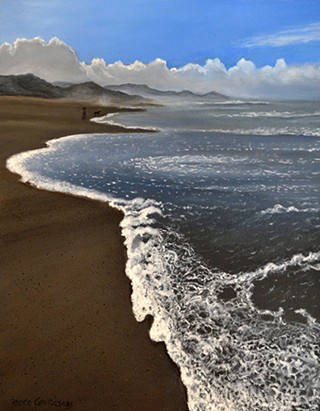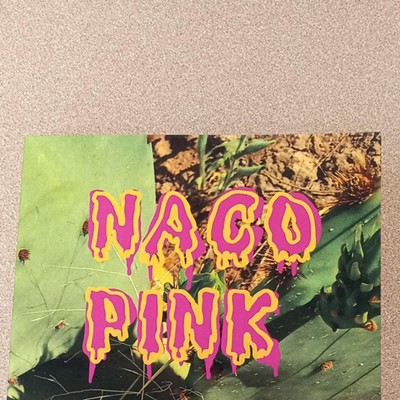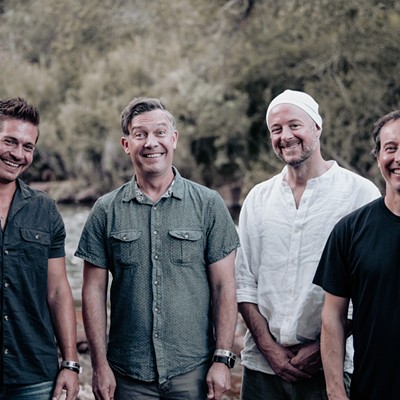The Sonoran summer is here. Never mind that the solstice—the longest day of the year and the official beginning of summer—takes place this Friday, June 21. In my reckoning, our desert summer started 10 torrid days ago, on June 10, when the temps first hit 100 degrees (then climbed to 101).
Time was that the art scene slowed down in our scorching summers. No más. Nowadays, apart from shutting down on the Fourth of July and maybe for a week or two allowing for an escape to the cool pines, most of the galleries and all of the museums soldier through the hot months. Here's a look at a few of the summer shows.
"Oregon Coast," a bracing painting in Contreras Gallery's Small Works show, is just the antidote Tucson's heat calls for. The lovely painting, by gallery co-owner Neda Contreras, has everything you want at the seashore: breaking waves, blue skies, empty beaches and, this being Oregon, sloping mountains coming down to the sea.
Other seasonal pieces include Elizabeth Frank's "Manos Santas" (Holy Hands), a 3D work that has perky pink posies growing out of a gardener's white gloves and Nina Duckett's painting of a mother bird sprouting a nest, flowers and baby bird out of her head. Get thee quickly to the gallery to see these cooling works: the show ends Saturday, June 29. In July, Martín Quintanilla fills the gallery with a solo show of his "arte-narco" paintings. 10 a.m. to 3:30 p.m., Wednesday through Saturday; 110 E. Sixth St.; 398-6557; contrerashousefineart.
There's also still time to see a trio of shows at MOCA-Tucson, but not much: they close on June 30. GROPING in the DARK, the main exhibition, features 10 artists whose installations and videos investigate ecology and the ways people use the land. But ecology here is not just about the natural world; it also embraces human-created social systems. And, yes, as curator-in-residence Alex Young notes, the show was created "in response to our ecological moment"—when our federal government is busily welcoming back toxic pollution.
Art duo Sarah Ross and Ryan Griffis imagine "A Great Green Desert" in a hopeful installation that pairs photos of clear blue skies and healthy green plants with a series of old-fashioned globes of the world. But Caleb Lightfoot and J. Eric Simpson, another art team, skewers chemical farming that spoils finely tuned ecosystems. Their "Cash Crop," an installation colored a sickly electric purple, targets Round-Up, a herbicide that has been listed as "probably carcinogenic" by the World Health Organization.
Another MOCA exhibition, From Here to Eternity, gives Tucson a chance to see the work of seven new BFA grads and 12 MFA's from the UA. These fresh new artists tackle hard subjects from war to capitalism. And in a first, MOCA stages New Histories, a state-wide juried show of some 65 works by young Arizona artists from kindergarteners to high school seniors.
MOCA hosts Free Third Thursday: Yappy Hour, from 6 to 8 p.m., Thursday, June 20, welcoming both humans and dogs. Homo sapiens get free performances, music and artmaking, along with a cash bar and food truck, while the canines eat treats and gulp "dog cocktails." If you don't have a puppy, you can adopt one on the spot from S.A.F.E. (Saving Animals from Euthanasia).
Etherton Galley kicks off its summer show, Jack Dykinga: Grand Canyon National Park, 1919-2019, this Saturday, June 22, with a reception from 7 to 10 p.m. An environmentalist and Pulitzer Prize-winning photographer who lives in Tucson, Dykinga will sign copies of his new book, Grand Canyon: A Photographer's Favorite Viewpoints.
Honoring the park's centennial, the exhibition shows Dykinga's contemporary color photos of the canyon's wonders alongside vintage photos by William H. Bell, a 19th-century photographer who came West with the Wheeler expedition. Also on view are works by Ansel Adams, contemporary photographer Mark Klett, and many canyon lovers. The show runs through Sept. 7; 11 a.m. to 5 p.m., Tuesday through Saturday; 135 S. Sixth Ave.; 624-7370; www.ethertongallery.com. Closed for vacation June 30 through July 7, reopening July 8.
The 200th birthday of Walt Whitman inspired the big new show at the Center for Creative Photography. In collaboration with the UA Poetry Center, the center is hosting A Portrait of Poetry: Photographs and Video by B.A. Van Sise. The photographer, a descendent of the great American poet, exhibits some 70 unconventional color portraits of America's living poets, both famous and almost unknown. The poems that inspired the works hang next to each portrait. Van Sise and the poets collaborated on sometimes elaborate environmental settings. Rita Dove, for instance, an African American and former poet laureate of the U.S., is photographed in front of Monticello, home of the slave-owning Thomas Jefferson.
A companion exhibition displays photos of America that Edward Weston made on a cross-country trip for a 1940s luxury edition of Whitman's seminal poem "Leaves of Grass." The show runs through Nov. 23. 1030 N. Olive Road on the UA campus; 9 a.m. to 4 p.m. Tuesday through Friday, 1 to 4 p.m. Saturday; 621-7968; ccp.arizona.edu, Closed on the 4th of July. Free.
Mayoral candidate Steve Farley—who is facing fellow Democrats Regina Romero and Randi Dorman in the August primary—is a professional artist, best known in the art world for his public art piece on Broadway that pictures Tucsonans of long ago in large-scale photo tiles. But he's also a photographer and ArtsEye, inside Photographic Works, has mounted All Together Now, a small solo show of his color images. Most of the 15 works are digital composites pieced together on the computer, a technique that allows him to create photos with casts of thousands, such the three-part "Arizona Stadium Triptych" capturing the fans and players at a UA football game.
Farley got a wide photo of the Arizona state capitol—where he worked as a state rep for six years and as a senator for another six—with the state senators standing at attention and citizens looking down from the balcony. But one serene image is far from the madding crowd: a long horizontal slice of Mount Lemmon trees and plants in autumn. The election is in August, but Farley's artwork will be until September. 3550 E. Grant Road.; 9 a.m. to 6 p.m. Monday through Friday; 10 a.m. to 5 p.m. Saturday; 327-7291; www.artseye.com.
Raices Taller 222 Art Gallery has already begun its annual plea for the summer rains, in the form of ¡Chubasco! A Monsoon Exhibition. The show of paintings, drawings, photos, sculptures and mixed-media works opened last weekend and it's only up until July 27. So here's hoping that the art can work its magic quickly and bring on the rains. 1 to 5 p.m., Friday and Saturday; 218 E. Sixth St.; 881-533; www.raicestaller222.com. ■













